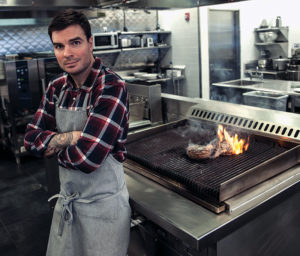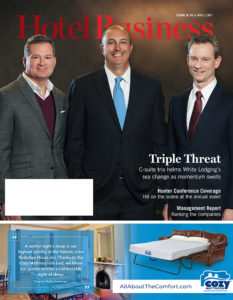 When you hit your thirties, you really start to look around, pretty much—as Nobel Laureate Bob Dylan would say—to know which way the wind blows.
When you hit your thirties, you really start to look around, pretty much—as Nobel Laureate Bob Dylan would say—to know which way the wind blows.
Here in the nation’s heartland, 32-year-old, Indiana-based White Lodging Services is finding the atmosphere just balmy, having recently reassessed how it wants to proceed into the future while keeping the values and culture first established by its founder and chairman Bruce White in 1985.
Only underway for the past seven weeks, the company’s new direction has called for rebranding efforts, stemming largely from strong growth—17 hotels are in the pipeline out to 2018—and the need to support such growth with not only hundreds, but thousands, of new associates, from line level to management (see sidebar).
Working together to helm the sea change are White Lodging’s top guns: Deno Yiankes, president/CEO of Investments & Development, and Ken Barrett, president/CEO of Hospitality Management, along with SVP/Chief Revenue Officer, Full Service Chris Anderson. While they concentrate on this current chapter in the company’s history as a developer, owner and manager of full- and select-service hotels in the United States, the trio also is bringing unique perspectives to White Lodging’s portfolio momentum. Yiankes, a well-known industry veteran is combining his 27 years of experience at White Lodging with the fresh outlooks of Barrett and Anderson, who joined the company in 2016 and 2015, respectively.
According to Yiankes, whose division handles deal sourcing, development functions, equity deployment, construction/project management and underwriting, the number of hotels being added and in the pipeline doesn’t seem out of character for the company from his long-time view.
“I don’t ever recall a period where we had slow growth. We tend to be one of the more consistently growing private owner/operators in the landscape and that’s really driven by our financial model and the stability we have,” he said. “Our growth historically generally has been in the 10-15% compounded annual growth rate per year. We’ve had years where we’ve been in the mid- to high teens, but very rarely have we dipped under 10% per year. And our current three-year outlook tends to be in that 10-15% range again, probably more in the 10-12% range and that’s primarily driven by our base numbers getting much more significant.”
White Lodging itself has become much more significant in terms of its industry presence and profile. Established with a single hotel, the company has developed more than 120 hotels and provides management services for more than 165 premium-branded hotels, which includes 26 brands and 30 restaurants in 19 states across the U.S.
“We cracked a billion dollars in managed sales in 2013 and we’ll exceed $1.5 billion in 2017,” said Yiankes. “Frankly, it’s very consistent growth but we happen to be in an accelerated period and some of that is driven by this notion of getting more heavily weighted in the urban and major lifestyle hotels. A lot of these urban markets we’re going into, the natural cycle times have just taken longer and you can’t always control that.”
Examples of primary cities and the type of projects White Lodging will add over the next 24 months includes the dual-branded Aloft/Element Austin Downtown (where in 2006 the company opened the first dual-branded property in the U.S.—the Courtyard by Marriott and Residence Inn by Marriott) and AC/Le Méridien Denver Downtown; the Moxy Chicago; and Homewood Suites by Hilton Louisville in Kentucky.
Yiankes, who during his time at White Lodging has seen the portfolio grow from four hotels to its current 165-plus, added the expectation is for continued accelerated growth for the next three to four years.
When assessing the portfolio, Barrett, who joined White Lodging as SVP/CFO after serving for 10 years as SVP of asset management at Strategic Hotels & Resorts, suggested he has the advantage of having seen White Lodging as an “outsider” and now an “insider.”
“When I look at the portfolio of hotels it’s very new, it’s very innovative. The hotels they’ve put together over the past number of years—duplexes and triplexes—are new to the industry. Then I look at what they’re doing today with the brands they’re merging together. When the duplex [model]first started, they were [hotels]from the same brands; today, they do them from different brand families,” said Barrett.
Such was the case in 2013 when White Lodging and Unique Friedman Properties developed and opened a triplex property in Chicago’s River North District. The complex includes the (then Starwood’s) 272-room Aloft Chicago City Center; Marriott’s 180-room Fairfield Inn & Suites Chicago Downtown River North; and the 212-room Hyatt Place Chicago/River North.
“We were able to secure three power brands in one location and take advantage of the synergies: one construction loan, one building, one operating team,” said Yiankes.
Barrett noted hotels in the portfolio also often play against type in terms of STR’s chainscales. “It doesn’t matter if it’s a Fairfield Inn or JW Marriott; it makes an architectural point in the market it exists in. There’s a number of hotels I look at in the White Lodging portfolio that would be able to compete in the chainscale one or two brands above where it is…definitely a differentiator,” he said.
Also creating a difference is the “fresh set of eyes and talent” such as Barrett and Anderson have brought on board, noted Yiankes.
“It’s opened our eyes. We’ve been an organization that’s kind of had our head down and just executing. We’re not ones to always ‘smell the roses’; we’re worried more about planning,” he said. Yiankes harked back to 2011 as one of the turning points for where White Lodging is today, citing the completed development by the company of Marriott Place Indianapolis, a $436-million, public-private partnership project that yielded a 34-story JW Marriott of 1,005 rooms; a 297-room Courtyard by Marriott; a 168-room Fairfield Inn and Suites; and a 156-room SpringHill Suites by Marriott.
At the time, the late Dean White, who headed the family-founded Whiteco Industries Inc. and his son, Bruce, were both invested in the hotels. The elder White owned the JW Marriott and the Fairfield Inn and Suites via LLCs while the Courtyard and SpringHill Suites were owned under an LLC of which Bruce White had the majority share and Indianapolis-based REI Investments the minority stake.
“The JW Marriott was a milestone hotel for us as an organization in many ways. That hotel was really the first time that we said: ‘You know what? Let’s do something significant on the exterior. [Dean White] clearly viewed it as his legacy to the state of Indiana,” said Yiankes.
The elder White, considered a driving force behind White Lodging’s sale in 2006 of 100 hotels to BET Network founder Robert L. Johnson’s RLJ Development for $1.7 billion, passed away last September at the age of 93.
“White Lodging was always known for operational excellence, but what got me was they were always in the news with some fantastic property or they were building during the downturn; they just kept showing up,” said Anderson, explaining why he was attracted to the company. “We’re kind of a modest organization. If we did something great today, we’re going to talk about how we can do something even better tomorrow. We don’t necessarily sit back and pat ourselves on the back.”
That said, Anderson stressed the company is “a lot more innovative than one on the outside would think… The entire company thinks we’re not just building hotels; we’re building great places to stay. And we understand it’s not just a hotel stay; it’s an experience that you’re having while living life on the road. As we build these hotels, I think every hotel will have to be a lifestyle hotel by 2020; it’s just the way people are traveling.
“Our chairman, Bruce White, understands we need to do things better than the next guy,” added Anderson. “And the brands love us because we always build higher than their standards, to our standards. We’re thinking about how to create a true experience that people will write home about.”

Bringing its culture and staff members, such as Corporate R&D Chef Andrew Ashmore, to the fore is part of White Lodging’s ongoing strategies toward next-gen travelers and potential employees.
Perhaps owing to the company’s Midwest roots, those experiences aren’t going to be the weird ones folks write home about or tweet out on social media (although White Lodging is carving a distinct presence in Austin, where it has more than 25 hotels and seven brands).
Noted Yiankes: “You don’t see us necessarily going to trendy markets that may be very ‘hot’ and ‘flavor-of-the-month’ type deals. We have a feasibility background and the word that comes to mind is sustainability. We want to be able to look at ourselves and say: ‘You know what? If we do something special in this market, it’s sustainable. We need to be convinced we could be minimally number two, but ideally number one—what we call our natural rank in our competitive set.”
“We don’t build hotels just to flip hotels,” said Anderson, who is responsible for developing and executing the revenue strategy for White Lodging’s full-service and lifestyle portfolio of hotels and restaurants, as well as for new concepts, branding and experiential marketing and activation. “If you look at [our]competitors that’s what they do. So they’re not looking to have that number-one natural rank in a market. We’re also looking at the value proposition we’re giving that market. That’s why in markets we have multiple brands and multiple products.”
Yiankes noted the company is both strategic and opportunistic as it suits, citing White Lodging’s scale and financial capacity to do a variety of deals.
“We’re spoiled. We’re not in a scenario where we come up with the idea and then figure out how we’re going to fund it. I’m probably the most spoiled development guy in our industry in that respect because of our internal funding capacity,” chuckled Yiankes.
“We’re also an owner/manager,” said Barrett. “So, when we actually get into a market we can generate better returns than perhaps someone entering the market. When you see us go into a specific market, you’ll see us dive in. When we add another hotel, because we own it, we’ve got great opportunities to build things, but because we also manage it, I don’t have to worry about hiring as many people as the next guy does in order to be able to do well in those hotels. Because of our scalability we actually have above-market returns as we grow in a market.”
Barrett indicated White Lodging would continue adding traditional upper-upscale hotels such as Westins, as well as Le Méridien, several AC by Marriott hotels and Moxy hotels.
“The millennials basically have taught a set of travelers to travel a certain way. I know millennials is overused, but they were just enabling the market. They taught us all how to binge watch in a matter of a week,” said Barrett. “It’s not that they’re the majority of our travelers, but they make up 50% of our workforce and 50% of our travelers. And where they go, everyone else tends to go, so we’ve got to make sure we build brands that are places, quite simply, that people will Instagram or tell somebody they are staying there on Facebook. You don’t do that with your father’s Oldsmobile.
“We pick newer brands and we basically take the brands and make them even better,” Barrett added. “A lot of the brands that we do, it’s not required that they have an F&B component or rooftop bar or spa, but we do it anyway because we know it’s the right thing to do and our returns will be justified. It is about picking the right brands. I can’t say it enough.”
Anderson said while newer brands are easy to open with a service strategy, the company makes as much effort with its legacy brands. “We’ll have a suburban Marriott that we completely reimage and turn into a lifestyle hotel. You create a story, you tell the story, you make sure it’s connected and that locals embrace it. You have to articulate that very specifically in order to make that happen,” he said. Enhancements include new bars, F&B components, music, the right lighting, updated uniforms and changing style guides.
Yiankes pointed out in the past the major chains, e.g., Marriott, Hilton, Hyatt, didn’t have so-called lifestyle brands. “Today, they’re all under those three umbrellas for the most part, and that’s been a big factor. We’re a belts-and-suspenders developer/owner. We love being able to be creative, but we also like the safety net a brand brings to the table for financing. To me, it’s the best of both worlds because of what we used to get challenged on in terms of trying to be a little edgier. Today, we’re not getting fought by the legacy brands; they’re actually supporting it and most of the prototypes are reflecting it,” he said.
Comfortable in the five to 30 top MSAs, White Lodging leads with urban markets for its portfolio. “We’re not necessarily looking at or feel we need to be in the coastal top three or four—L.A., San Francisco, New York City. We’re comfortable in metro areas of two to five million [population]. But we by no means have walked away from our roots of doing suburban deals. We got a little bit away from it the past five years because of the giant, sucking sound these mega, thousand-room, triplex type of hotels make as an organization. Even though we have scale it impacts us from a resources standpoint. The white space isn’t as great for us to add value but we absolutely still have a desire and an affinity to develop suburban hotels as well,” said Yiankes.
At a time when many lodging companies are going “asset light” with real estate holdings, White Lodging is looking to own more hotels. “We feel there’s increased opportunity. The industry is so fragmented and the white space for us where we can add value with our scale and our financial capacity is in these urban, larger-scale projects, i.e., projects that are $100 million and larger; it grows exponentially,” he said.
The company also is adamant about maintaining quality, Yiankes indicated, noting at the River North project, which is coming up on its fourth year in business, White Lodging already has redone one of the brand’s lobbies “because we thought we left something on the table. It was a major, over-the-top investment for only a three-year-old hotel at the time.
“If we’re sincere about being slightly disruptive in our space you have to be willing to do those things,” said Yiankes. “We’re blessed with owners that are willing to support it. Our ownership base basically is coming to us saying: ‘What could we be doing to make these assets better?’ That’s a blessing. We’re not scrounging for CapEx dollars like our very fragmented industry [where]most owners and operators are. That’s not arrogance. That’s not anything other then it allows us to be our best and continually challenge the model.” HB
White Lodging Services Milestones
Chairman Bruce White established White Lodging 32 years ago with a single hotel. Since then, the company has developed more than 120 hotels and provides management services for more than 165 premium-branded hotels, which includes 26 brands and 30 restaurants in 19 states in the United States. Here are some of the company’s milestones:
1985 Bruce White forms White Lodging Services Corp. with a single hotel.
White Lodging builds its first three properties.
1990 White Lodging debuts the first Fairfield Inn & Suites franchise, opening the hotel in its headquarters city of Merrillville, IN, as the brand’s first franchisee.
1995 White Lodging opens its 25th hotel.
2000 White Lodging opens the 50th hotel in the company’s portfolio.
2005 White Lodging opens its 100th hotel.
2006 White Lodging sells 100 properties to RLJ Development, establishing long-term management contracts for these properties.
White Lodging opens the first dual-branded property in the U.S. with the Courtyard by Marriott and Residence Inn by Marriott Austin Downtown.
2008 White Lodging debuts the first dual-branded hotel in Chicago with the opening of the Residence Inn by Marriott and SpringHill Suites by Marriott Chicago/River North.
2011 White Lodging opens the first JW Marriott in the Americas with more than 1,000 guestrooms.
2013 White Lodging opens the first branded triplex hotel development in Chicago’s River North neighborhood, combining a Hyatt Place, Fairfield Inn and Aloft in one property.
White Lodging opens the first Hyatt-branded hotel in downtown Austin in more than 20 years: the Hyatt Place Austin Downtown.
2015 White Lodging opens the largest JW Marriott in the Americas with the JW Marriott Austin.
2017 White Lodging expects to open the first Marriott/Starwood property since the merger of the two companies in 2016: the AC Hotel by Marriott Denver Downtown and Le Méridien Hotel Denver (495 total keys).
White Lodging’s rebranding includes new ads, messaging
MERRILLVILLE, IN—“Success knows no boundaries.” “Passion works here.” These are two taglines that embody the new rebranding efforts of White Lodging Services.
Chris Anderson, the company’s SVP and chief revenue officer, full service, told Hotel Business the reason for the rebranding stemmed from the company’s robust growth. With 165 hotels in its portfolio, the locally based company will open 17 hotels in the next 18 months. With that pace, it will need to hire some 4,000 employees in the next 24 months. And attracting and retaining good employees requires being a place and a culture they want to be a part of, he noted.
In doing market research, the company discovered it was best known for operational excellence. “That’s what we’re known for—operating great hotels,” said Anderson. However, the research showed one term that wasn’t being used to describe the company, both internally and externally—innovative.
But, said Anderson, as the company delved into its past, it realized it was a company of firsts. “We are an innovative company, but in the past, quite frankly, we just haven’t told that story. So part of our rebranding is to let people know we’re hip and innovative, as well as being really great at operating hotels.”
The owner/operator also wants the industry to know it’s kicking the convention hotel management side of the business into high gear. “We are aggressively going to be in the management business for large, convention hotels,” said Anderson. “We want management contracts, and we also want to insert ourselves into the convention space.” White Lodging already had experience in that arena with properties like the JW Marriott in Indianapolis and Austin, and “not many people are in that game.”
“That’s different for us because we’ve said no in the past to some larger contracts. We wanted to focus on our own stuff, but we’re now big enough where want to own hotels and we want to manage for others,” he added.
As part of its rebranding, the company has a new logo, website, multimedia content and overall messaging. For example, a brand anthem video has been attached to its website, which gives a summary of the company and what it’s about, from its 1,000-room hotels to the 150-room Moxy it’s building. “We can get people fired up and passionate,” said Anderson.
Anderson said the company is “making sure our GMs [understand]they work for one of the fastest-growing, trendsetting, forward-looking companies in America. We’re going to be doing activation with the website where we’re going to take these ‘Passion works here’ stories from property levels. They’ve got a venue where they can be heard and tell their story, and it’ll automatically come up through the website.”
The site, he noted, was a big part of the rebranding, as White Lodging wanted something more modern and contemporary. “The old one was static and the pictures were yearbook style. Even though we’re a diverse organization, we weren’t showing it that way,” he said.
And that was a problem because the company needs to hire 4,000 new employees in the next 24 months, and the first place potential employees go is a company website. “Our website didn’t inspire anyone to want to work for that company. They get the fact that there might be some great opportunities because we’re growing, but they couldn’t tell what the culture was,” he said. “We think this new site is a better portal in which to get the best of the best to call us.”
And, Anderson said, it’ll be a means to retain the 12,000 employees the company already has. “Retention is a difficult task,” he said. “We want them to be able to be engaged with the company and at the same time attract new people.”
So where did the taglines come from? “We want people to come to work here that will stay forever. People, especially millennials, will tell you what they want: it’s got to be a place that has similar values to their own and it has to have some cachet,” he said. “It’s got to mean something, which means its reputation out in the street and digitally has to be one they can be proud of.
“‘Success knows no boundaries’ truly means that,” Anderson continued. “We get we’re not living in a world where your dad works for Ford for 40 years and retires. People get tired of doing the same thing. The message from us: there are no boundaries. You can go from culinary to front office, from sales to restaurants, and you can go across the country. If you want to move to Austin, we have 30 hotels in Austin. We want them to know we support the movement and training because we truly believe we can have a place for you to be with White Lodging for 30 years.
“The other tagline we work with is ‘Passion works here.’ Millennials want to work someplace where they can bring their passion to work and bringing that passion actually helps them be successful,” he said. “What we’re doing, from a grassroots standpoint, is we’re having all of the associates tell their stories, and as they tell their stories, it might be an Instagram post that fuels up through our website. We want them to bring that to light and we want them to know we support that to bring their passion to life. When people do that, they’re happy, and when people are happy, it makes for great guest service, and great guest service means the guest will come back. It’s just a great formula.” —Nicole Carlino


